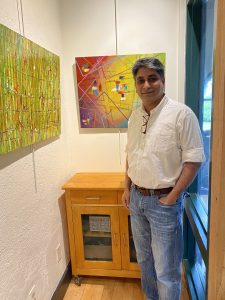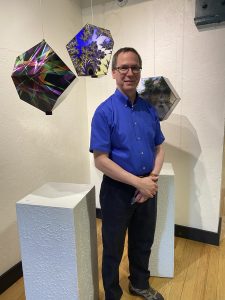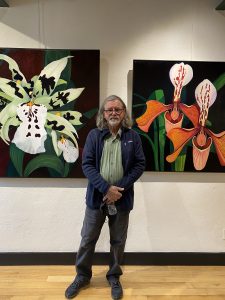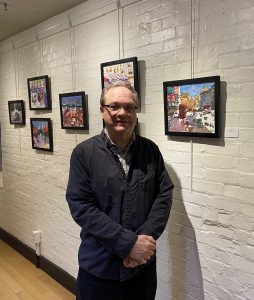If you ever think about science and art, it is likely as two distinctly opposite concepts. Entertaining them together, however, is as easy as being familiar with the works of a group as diverse as da Vinci, Goethe, Samuel Morse, Beatrix Potter, Hedy Lamarr and Brian May! Each brought these opposing disciplines together in their particular fields. You can see this play out with a local flavor during May and June at the Arts Barn in the virtual exhibition Scientists Who Are Artists. Curated by Mary Weiss-Waldhorn, the exhibition showcases the work of six scientist artists.
During the livestreamed artist reception on Facebook in mid-May, I had the opportunity to speak with four of the artists. As I learned each of their stories, I saw comparative similarities in the evolution of their art and how the elements that linked it to their scientific occupations commingled. The diversity of media in the show and the interplay connecting art and science became increasingly fascinating! Like interlocking blocks, the beauty inherent in nature and expressed in scientific research is likewise alive and expressive in the creation of visual art.
 North Bethesda resident and self-taught artist Shyam Rele is a chemist working in vaccine and drug development. His bold abstract acrylics were created during the pandemic and relate to his vaccine research. Rele sees them as a vehicle to bring order to chaos as a vaccine brings a proliferating disease under control…celebrations of a return to normal!
North Bethesda resident and self-taught artist Shyam Rele is a chemist working in vaccine and drug development. His bold abstract acrylics were created during the pandemic and relate to his vaccine research. Rele sees them as a vehicle to bring order to chaos as a vaccine brings a proliferating disease under control…celebrations of a return to normal!
Painting was an interest that he originally explored with his daughter while spending time drawing and coloring. He talked about how he wanted to show her the color spectrum and, as they painted, his interest grew. “Colors speak to me—they come together and say something.” His Quarantine is particularly relevant. The groupings represent different countries, social distancing and misinformation. The hexagons symbolize the lungs which are most affected when exposed to the Coronavirus. Rele’s abstracts reveal a symmetry that one may associate with order and preciseness, but they also elicit a joy of color and form that attract you with their vibrancy. They are reminiscent of the colorful planet-like nubby orbs of magnified virus cells that we have seen so much of in the past 18 months.
 Gaithersburg photographer Thomas Germer is an optical physicist studying the properties and interactions of light. He says that his suspended sculptures and prints, which illustrate the scientific and mathematical principles he works with daily, fit together like the shapes he creates to display them. Photographing spherical panoramas of primarily architectural and historical venues, both in the US and abroad, as well as fractal patterns and abstract shapes and designs, he digitally manipulates them to modify perspective, bending them around the angles of the geometric figures he creates from fiberboard. Germer acknowledges that it is an exacting and painstaking art.
Gaithersburg photographer Thomas Germer is an optical physicist studying the properties and interactions of light. He says that his suspended sculptures and prints, which illustrate the scientific and mathematical principles he works with daily, fit together like the shapes he creates to display them. Photographing spherical panoramas of primarily architectural and historical venues, both in the US and abroad, as well as fractal patterns and abstract shapes and designs, he digitally manipulates them to modify perspective, bending them around the angles of the geometric figures he creates from fiberboard. Germer acknowledges that it is an exacting and painstaking art.
Traveling around the sculptures to glimpse alternative views and dimensions envisions the original photograph and a realization that the art of digitally directing an image can enhance its beauty and line. A favorite piece in the exhibit is Poincaré which shows facets of the grave of Henri Poincaré, a French mathematician who is one of Germer’s inspirations.
 Originally from St. Louis, Frederick artist Craig Cavin is a newly retired biologist who worked with plant pathogens. As an art student living on Maui in the 70s, he developed an interest in horticulture after observing fungal growths on native plants. He went on to study tropical agricultural and plant pathology and worked with native American tribes researching exotic weeds. He moved to Frederick to study a fungus unknown in the US at that time while earning an advanced degree in Environmental Biology. “I had a strong feeling for beauty in art but couldn’t translate it in the turbulent 70s, so I went back to college to learn how to translate it.”
Originally from St. Louis, Frederick artist Craig Cavin is a newly retired biologist who worked with plant pathogens. As an art student living on Maui in the 70s, he developed an interest in horticulture after observing fungal growths on native plants. He went on to study tropical agricultural and plant pathology and worked with native American tribes researching exotic weeds. He moved to Frederick to study a fungus unknown in the US at that time while earning an advanced degree in Environmental Biology. “I had a strong feeling for beauty in art but couldn’t translate it in the turbulent 70s, so I went back to college to learn how to translate it.”
Cavin said that the intuition and logic of science helped him convey his feelings about beauty into art. His large orchids reveal shades of unexpected color and asymmetrical shapes. Carroll Creek Water Lilies features beautiful, muted color and depth. Expansive fish prints created using the traditional Japanese method of Gyotaku, employing ink and rice paper to make an impression of the fish’s skin and transferring to a wood panel, are incorporated into designs exposing the myriad of natural textures most clearly notable in the bronze-tinged Redfish School 4.
 Watercolorist Paul Tooley, who shares a studio and worked together with Cavin at the USDA, is a retired plant pathologist. His interest in painting and drawing has been lifelong and his extensive travels during the past 20 years throughout Europe and to China have created a constant stream of visuals to recollect on paper. He calls his painting representational but loose. It leans towards abstract suggesting a place, figure or landscape without employing definitive line. The technique leaves interpretation to the viewer’s imagination as captured in Paris People.
Watercolorist Paul Tooley, who shares a studio and worked together with Cavin at the USDA, is a retired plant pathologist. His interest in painting and drawing has been lifelong and his extensive travels during the past 20 years throughout Europe and to China have created a constant stream of visuals to recollect on paper. He calls his painting representational but loose. It leans towards abstract suggesting a place, figure or landscape without employing definitive line. The technique leaves interpretation to the viewer’s imagination as captured in Paris People.
Tooley’s colors are rich and speak, evoking the movement and mood of his subject. “I like to blur the line between realism and abstraction,” he said. It allows him to completely leave behind the scientist who is dominated by facts and expose him to the challenging subtleties of abstraction and even impressionism. He paints en plein air and likes that watercolor allows him to “explore the ephemeral” and maintain spontaneity. He also works in charcoal and pen and ink and showed Clifftop Jam in this medium. Tooley’s watercolors are enhanced by using varnish to seal them rather than utilitarian glass. This produces a slight matte luster that complements his handmade black wooden frames, setting off his work in a polished yet rustic manner.
Environmental biologist Robert Strasser’s ceramic reliefs, pottery vessels and vases, wood sculptures, three-dimensional shapes and biospheres showcase his fine craftsmanship and love of nature. Biosphere 3 is a particularly interesting orb on a pedestal featuring earthy-colored ceramic reliefs of flora and fauna.
Researcher Richard Weiblinger, whose research focused on interactions of light with the cornea, showed sparkling beach and coastal themed photography that provides plenty of space and blue sky for contemplation, particularly in the standout Red Cabanas 1540.
Scientists Who Are Artists is being exhibited virtually by the Arts Barn through June 26th. For more information, 301-258-6394 or email artgalleries@gaithersburgmd.gov. View the recording of the live reception on Facebook.